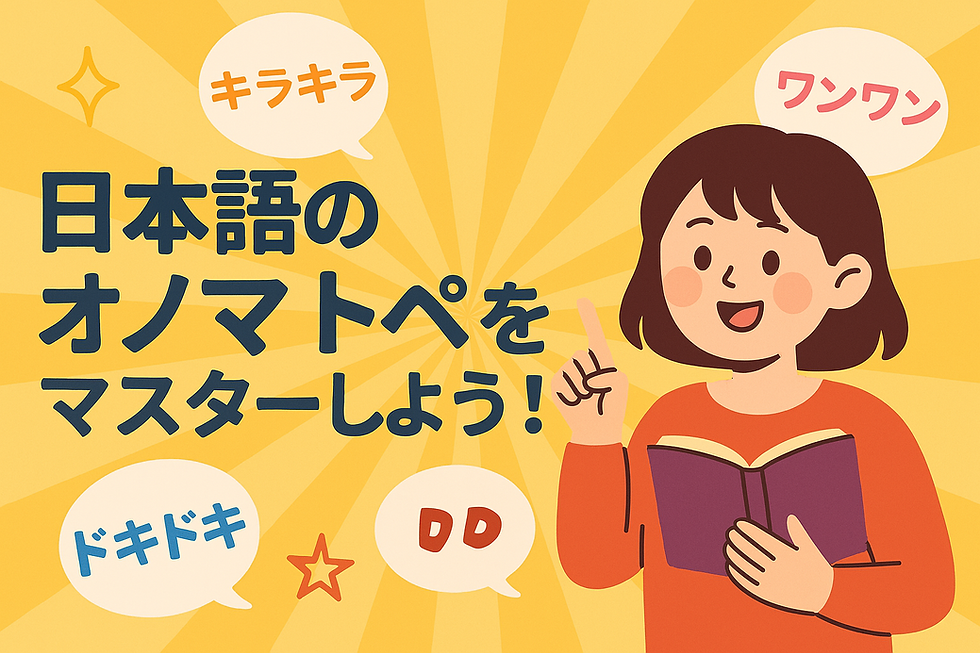日本語のオノマトペ(擬音語・擬態語)をマスターしよう!
- meixiao
- 4月6日
- 読了時間: 4分

The English version is below.
日本語学習者にとって、オノマトペ(擬音語・擬態語)は難しく感じるかもしれません。しかし、日本語ネイティブの日常会話やマンガ、アニメにはオノマトペがたくさん登場します。オノマトペを使いこなすことで、あなたの日本語表現はもっと自然で豊かになります!
オノマトペとは?
オノマトペ(onomatopoeia)は、音や様子を言葉で表す表現です。日本語のオノマトペには大きく分けて以下の2種類があります。
1. 擬音語(ぎおんご)
実際の音を表す言葉です。例:
ドアが「バタン!」と閉まる
雷が「ゴロゴロ」鳴る
猫が「ニャー」と鳴く
2. 擬態語(ぎたいご)
音はないけれど、様子や気持ち、動作などをイメージで表す言葉です。例:
人が「ニコニコ」笑う
雨が「しとしと」降る
頭が「ガンガン」痛い
オノマトペを学ぶメリット
会話表現がより自然に! ネイティブらしい話し方が身につきます。
日本の文化や感覚を理解しやすくなる! マンガやアニメ、ドラマに登場する表現がわかるようになります。
語彙力がアップ! 形容詞や副詞の代わりに使える表現が増えます。
よく使われるオノマトペ10選
オノマトペの覚え方のコツ
マンガやアニメで学ぶ! 自然な使い方がたくさん出てきます。
日記や作文に使ってみる! 「今日はぐっすり眠れました」「先生がにこにこしていた」など、実際に使ってみましょう。
イメージとセットで覚える! 言葉と一緒に絵や動画を見て覚えると効果的です。
まとめ:オノマトペを使って表現力アップ!
日本語のオノマトペをマスターすると、あなたの会話力や表現力は一段とレベルアップします。特に擬音語・擬態語は、ネイティブとの距離を縮めるカギになります!
これからも日本語学習を楽しみながら、オノマトペをたくさん使ってみましょう!
Master Japanese Onomatopoeia: Giongo and Gitaigo Made Easy!
For many Japanese learners, onomatopoeia (sound-symbolic words) can seem tricky. But if you’ve ever watched anime, read manga, or listened to daily conversations in Japanese, you’ve probably noticed these expressive words everywhere.By learning how to use onomatopoeia, your Japanese will become more natural and vivid!
What Is Onomatopoeia in Japanese?
Onomatopoeia in Japanese includes words that express sounds, feelings, movements, and conditions.They’re divided into two main types:
1. Giongo (擬音語) – Sound Words
These words imitate actual sounds.
Examples:
A door closes: batan! (バタン)
Thunder rumbles: gorogoro (ゴロゴロ)
A cat meows: nyaa (ニャー)
2. Gitaigo (擬態語) – Descriptive Words
These describe feelings, movements, or conditions without actual sound.
Examples:
Smiling happily: nikoniko (ニコニコ)
Light rain falling: shitoshito (しとしと)
Headache pain: gangan (ガンガン)
Why Learn Japanese Onomatopoeia?
💬 Speak More NaturallySounding like a native becomes easier when you use common onomatopoeic expressions.
🎌 Understand Japanese CultureYou’ll catch more meaning in anime, manga, and casual conversations.
🧠 Expand Your VocabularyThese words often replace adjectives or adverbs, giving your speech variety and emotion.
10 Common Japanese Onomatopoeia
Tips for Learning Onomatopoeia
Use Anime and MangaThese are full of real-life examples of onomatopoeia in natural context.
Try Using Them in WritingUse them in journal entries:“I slept gussuri last night” or “My teacher was nikoniko today.”
Connect with ImagesVisuals help a lot. Try flashcards with pictures or animated examples.
Conclusion: Boost Your Japanese Expression with Onomatopoeia!
Mastering Japanese onomatopoeia will make your speech more expressive and closer to native-level communication.Giongo and gitaigo aren’t just fun—they’re a key to understanding Japanese culture and improving fluency.
Keep practicing and try using onomatopoeia in your daily Japanese! You'll sound more natural and confident before you know it.



コメント